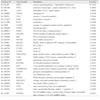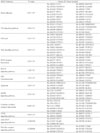1. van Winkelhoff AJ, Carlee AW, de Graaff J. Bacteroides endodontalis and other black-pigmented Bacteroides species in odontogenic abscesses. Infect Immun. 1985. 49(3):494–497.

2. Seltzer S, Farber PA. Microbiologic factors in endodontology. Oral Surg Oral Med Oral Pathol. 1994. 78(5):634–645.

3. van Steenbergen TJM, van Winkelhoff AJ, Mayrand D, Grenier D, De Graaff J. Bacteroides endodontalis sp. nov., an asaccharolytic black-pigmented Bacteroides species from infected dental root canals. Int J Syst Bacteriol. 1984. 34(2):118–120.

4. Hashioka K, Yamasaki M, Nakane A, Horiba N, Nakamura H. The relationship between clinical symptoms and anaerobic bacteria from infected root canals. J Endod. 1992. 18(11):558–561.

5. Machado de Oliveira JC, Siqueira JF, Alves GB, Hirata R, Andrade AFB. Detection of Porphyromonas endodontalis in infected root canals by 16S rRNA gene-directed polymerase chain reaction. J Endod. 2000. 26(12):729–732.

6. van Winkelhoff AJ, van Steenbergen TJ, Kippuw N, De Graaff J. Further characterization of Bacteroides endodontalis, an asaccharolytic black-pigmented Bacteroides species from the oral S cavity. J Clin Microbiol. 1985. 22(1):75–79.

7. Tanner AC, Paster BJ, Lu SC, Kanasi E, Kent R Jr, Van Dyke T, Sonis ST. Subgingival and tongue microbiota during early periodontitis. J Dent Res. 2006. 85(4):318–323.

8. Kumar PS, Griffen AL, Barton JA, Paster BJ, Moeschberger ML, Leys EJ. New bacterial species associated with chronic periodontitis. J Dent Res. 2003. 82(5):338–344.

9. Dahlén G, Leonhardt A. A new checkerboard panel for testing bacterial markers in periodontal disease. Oral Microbiol Immunol. 2006. 21(1):6–11.

10. Ross R. Atherosclerosis-an inflammatory disease. N Engl J Med. 1999. 340(2):115–126.
11. Lüscher TF, Barton M. Biology of the endothelium. Clin Cardiol. 1997. 20:11 Suppl 2. II3–II10.

12. Kinlay S, Libby P, Ganz P. Endothelial function and coronary artery disease. Curr Opin Lipidol. 2001. 12(4):383–389.

13. Willerson JT, Ridker PM. Inflammation as a cardiovascular risk factor. Circulation. 2004. 109:21 suppl 1. II2–II10.

14. Libby P, Ridker PM, Maseri A. Inflammation and atherosclerosis. Circulation. 2002. 105(9):1135–1143.

15. Lusis AJ. Atherosclerosis. Nature. 2000. 407(6801):233–241.

16. Libby P. Inflammation in atherosclerosis. Nature. 2002. 420(6917):868–874.

17. Saikku P, Leinonen M, Tenkanen L, Linnanmäki E, Ekman MR, Manninen V, Mänttäri M, Frick MH, Huttunen JK. Chronic
Chlamydia pneumoniae infection as a risk factor for coronary heart disease in the Helsinki Heart Study. Ann Intern Med. 1992. 116(4):273–278.

18. Mendall MA, Goggin PM, Molineaux N, Levy J, Toosy T, Strachan D, Camm AJ, Northfield TC. Relation of Helicobacter pylori infection and coronary heart disease. Br Heart J. 1994. 71(5):437–439.
19. Hajjar DP, Fabricant CG, Minick CR, Fabricant J. Virus-induced atherosclerosis. Herpesvirus infection alters aortic cholesterol metabolism and accumulation. Am J Pathol. 1986. 122(1):62–70.
20. Epstein SE, Zhu J, Burnett MS, Zhou YF, Vercellotti G, Hajjar D. Infection and atherosclerosis: potential roles of pathogen burden and molecular mimicry. Arterioscler Thromb Vasc Biol. 2000. 20(6):1417–1420.
21. Epstein SE. The multiple mechanisms by which infection may contribute to atherosclerosis development and course. Circ Res. 2002. 90(1):2–4.

22. Espinola-Klein C, Rupprecht HJ, Blankenberg S, Bickel C, Kopp H, Rippin G, Victor A, Hafner G, Schlumberger W, Meyer J. Impact of infectious burden on extent and long-term prognosis of atherosclerosis. Circulation. 2002. 105(1):15–21.

23. Mattila KJ, Nieminen MS, Valtonen VV, Rasi VP, Kesäniemi YA, Syrjälä SL, Jungell PS, Isoluoma M, Hietaniemi K, Jokinen MJ. Association between dental health and acute myocardial infarction. BMJ. 1989. 298(6676):779–781.

24. Beck J, Garcia R, Heiss G, Vokonas PS, Offenbacher S. Periodontal disease and cardiovascular disease. J Periodontol. 1996. 67:10 suppl. 1123–1137.

25. Haraszthy VI, Zambon JJ, Trevisan M, Zeid M, Genco RJ. Identification of periodontal pathogens in atheromatous plaques. J Periodontol. 2000. 71(10):1554–1560.

26. Spahr A, Klein E, Khuseyinova N, Boeckh C, Muche R, Kunze M, Rothenbacher D, Pezeshki G, Hoffmeister A, Koenig W. Periodontal infections and coronary heart disease: role of periodontal bacteria and importance of total pathogen burden in the Coronary Event and Periodontal Disease (CORODONT) study. Arch Intern Med. 2006. 166(5):554–559.
27. Deshpande RG, Khan MB, Genco CA. Invasion of aortic and heart endothelial cells by
Porphyromonas gingivalis. Infect Immun. 1998. 66(11):5337–5343.

28. Dorn BR, Dunn WA Jr, Progulske-Fox A. Invasion of human coronary artery cells by periodontal pathogens. Infect Immun. 1999. 67(11):5792–5798.

29. Ross R. The pathogenesis of atherosclerosis: a perspective for the 1990s. Nature. 1993. 362(6423):801–809.

30. Paster BJ, Dewhirst FE, Olsen I, Fraser GJ. Phylogeny of Bacteroides,
Prevotella, and
Porphyromonas spp. and related bacteria. J Bacteriol. 1994. 176(3):725–732.

31. Dorn BR, Harris LJ, Wujick CT, Vertucci FJ, Progulske-Fox A. Invasion of vascular cells in vitro by
Porphyromonas endodontalis. Int Endod J. 2002. 35(4):366–371.

32. Gibbons RJ. Bacterial adhesion to oral tissues: a model for infectious diseases. J Dent Res. 1989. 68(5):750–760.

33. Falkow S. Bacterial entry into eukaryotic cells. Cell. 1991. 65(7):1099–1102.

34. Pearce E, Tregouet DA, Samnegård A, Morgan AR, Cox C, Hamsten A, Eriksson P, Ye S. Haplotype effect of the matrix metalloproteinase-1 gene on risk of myocardial infarction. Circ Res. 2005. 97(10):1070–1076.

35. Presta M, Camozzi M, Salvatori G, Rusnati M. Role of the soluble pattern recognition receptor PTX3 in vascular biology. J Cell Mol Med. 2007. 11(4):723–738.

36. Lee YW, Eum SY, Chen KC, Hennig B, Toborek M. Gene expression profile in interleukin-4-stimulated human vascular endothelial cells. Mol Med. 2004. 10(1-6):19–27.

37. Ito T, Ikeda U. Inflammatory cytokines and cardiovascular disease. Curr Drug Targets Inflamm Allergy. 2003. 2(3):257–265.

38. Chou HH, Yumoto H, Davey M, Takahashi Y, Miyamoto T, Gibson FC 3rd, Genco CA.
Porphyromonas gingivalis fimbria-dependent activation of inflammatory genes in human aortic endothelial cells. Infect Immun. 2005. 73(9):5367–5378.

39. Gagarin D, Yang Z, Butler J, Wimmer M, Du B, Cahan P, McCaffrey TA. Genomic profiling of acquired resistance to apoptosis in cells derived from human atherosclerotic lesions: potential role of STATs, cyclinD1, BAD, and Bcl-XL. J Mol Cell Cardiol. 2005. 39(3):453–465.

40. Fan T, Lu H, Hu H, Shi L, McClarty GA, Nance DM, Greenberg AH, Zhong G. Inhibition of apoptosis in
Chlamydia-infected cells: blockade of mitochondrial cytochrome c release and caspase activation. J Exp Med. 1998. 187(4):487–496.

41. Zhu H, Shen Y, Shenk T. Human cytomegalovirus IE1 and IE2 proteins block apoptosis. J Virol. 1995. 69(12):7960–7970.

42. Grütter MG. Caspases: key players in programmed cell death. Curr Opin Struct Biol. 2000. 10(6):649–655.

43. Xu G, Gong Z, Yu W, Gao L, He S, Qian Z. Increased expression ratio of Bcl-2/Bax is associated with crocin-mediated apoptosis in bovine aortic endothelial cells. Basic Clin Pharmacol Toxicol. 2007. 100(1):31–35.

44. Adams JM, Cory S. The Bcl-2 protein family: arbiters of cell survival. Science. 1998. 281(5381):1322–1326.

45. Toutouzas K, Androulakis G, Chatzigianni E, Davaris PS, Karayannis M, Konstadoulakis MM, Messaris E. Expression of c-myc and H-ras and absence of expression of p53 and bcl-2 genes in atherosclerotic human carotid arteries. J Clin Basic Cardiol. 2002. 5(3):253–256.
46. Dimmeler S, Breitschopf K, Haendeler J, Zeiher AM. Dephosphorylation targets Bcl-2 for ubiquitin-dependent degradation: a link between the apoptosome and the proteasome pathway. J Exp Med. 1999. 189(11):1815–1822.

47. Jung IK, Kim DM, Kim BY, Kim YG, Kim IJ, Kim TH, Park JY, Son SM, Yoo HJ, Lee MK, Lee BY, Lee IK, Cha BY. NF-kB and atherosclerosis. Biowave. 2007. 9(7):1–13.
48. Esemuede N, Lee T, Pierre-Paul D, Sumpio BE, Gahtan V. The role of thrombospondin-1 in human disease. J Surg Res. 2004. 122(1):135–142.
49. Vischer UM. von Willebrand factor, endothelial dysfunction, and cardiovascular disease. J Thromb Haemost. 2006. 4(6):1186–1193.

50. Dadgostar H, Zarnegar B, Hoffmann A, Qin XF, Truong U, Rao G, Baltimore D, Cheng G. Cooperation of multiple signaling pathways in CD40-regulated gene expression in B lymphocytes. Proc Natl Acad Sci USA. 2002. 99(3):1497–1502.

51. Mach F, Schönbeck U, Libby P. CD40 signaling in vascular cells: a key role in atherosclerosis? Atherosclerosis. 1998. 137:suppl. S89–S95.

52. Xu Q. Role of heat shock proteins in atherosclerosis. Arterioscler Thromb Vasc Biol. 2002. 22(10):1547–1559.

53. Haskard DO, Boyle JJ, Mason JC. The role of complement in atherosclerosis. Curr Opin Lipidol. 2008. 19(5):478–482.







 PDF
PDF ePub
ePub Citation
Citation Print
Print





 XML Download
XML Download